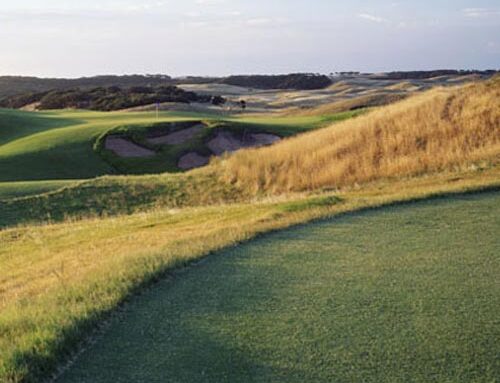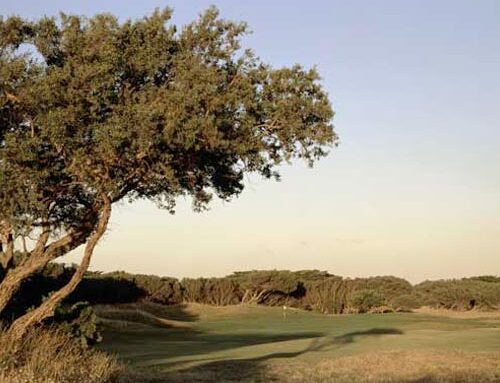Newcastle Golf Club
New South Wales, Australia
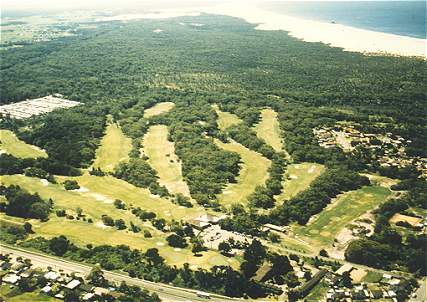
This overview shows the proximity of the Newcastle course to the Pacific Ocean as does….
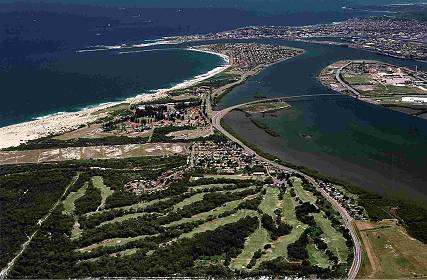
…this one. However, neither captures Newcastle’s superb sandy, rolling topography. A ferry was once required to reach the course.
Newcastle Golf Club is one of the hidden gems in world golf, a two hour car drive north of Sydney on the east coast of Australia. It has an ingredient common to many great courses: it is unique and reminds one of no other course.
In keeping with most courses designed during the Golden Age of golf course design, the architects left the land as they found it. Initially, Fred Popplewell Senior laid out nine holes in 1915. Seven of those nine holes remain today (the 1st, 2nd, 10th, 13th, 14th, 17th and 18th), as Eric Apperly wisely incorporated them into the eighteen hole course that the Club commissioned him to build in 1932.
Little earth was moved, either by Popplewell or Apperly, save in the building up of some of the green pads especially the one at the first. Otherwise, five blind tee balls exist to this day, signifying how the architects routed the holes up and over the rolling sand hills. Ti trees frame many holes with the Australian bush underneath every bit as penal as the gorse found in the United Kingdom. Over one hundred varieties of birds call the course home, including the famed Kookaburra. The result is a natural course that showcases the property’s best attributes, one of the highest compliments possible for any design.
Newcastle does not possess holes that readily take one’s breath away like New South Wales GC, another course that Apperly worked on extensively. Though it is within 1000m of the Pacific, the ocean is only heard, never seen, during the round. However, Newcastle, unlike New South Wales GC, doesn’t have a single indifferent hole. The cumulative effect is a balanced course that keeps the pressure on the golfer to stay in position throughout the entire round.
The dunes that continuously roll across the property aren’t massive in scale like the ones at Ballybunion or Lahinch. Rather, they range from ten to thirty feet, a size that lends itself to good golf qualities. Drives that aren’t hit straight and true tend to leave the golfer with a blind or semi-blind approach shot from an awkward angle. More importantly, Apperly did a world class job in situating as many green sites as possible on top of dunes so that the putting surfaces are often the high spots of their surrounds. By doing so, accurate iron play becomes a must as slightly off approach shots are pushed away from the crowned greens, leaving tricky recovery shots that seemingly bleed golfers to death one stroke at a time.
The greenside bunkering also deserves notice. Artistically, these small sand pits don’t compare to the majestic, sprawling ones found in Melbourne’s famed Sandbelt. However, the ones at Newcastle are highly effective at costing the player a shot. Because they are small in size, awkward stances are frequent. Also, the far side of some of the bunkers actually slopes toward the green, thus giving the player a downhill lie to an uphill green over a high grass lip, making recovery especially difficult. The bunkers could be better integrated into their surrounds but, as they stand, the bunkers remain appropriately penal, despite the invention of the sand wedge.
Similar to its namesake in Newcastle, Northern Ireland, several of its best holes feature a blind drive, including the second, fifth, tenth, and fifteenth as we see below.
Holes to Note
Second hole, 425 yards; The Newcastle flag by the clubhouse serves as the line for the blind tee shot over a dune 150 yards from the tee. The approach shot is a mid-iron up the hill to a green that is not in keeping with the others as it is curiously large and relatively flat. The Club records indicate that the Fred Popplewell originally created a much more interesting target in 1915. However, in the 1950s, the green committee eased the hole’s requirements when the green was brought forward and its contouring diminished. Work to restore Popplewell’s green is being considered.
Third hole, 240 yards; This 1/2 par hole plays straight into the winds off the nearby ocean. Though the distance is at the limit, like the 16th at Carnoustie, the real trick for the low marker is hitting the narrow green.The only consolation for the golfer is that the majority of this hole falls over flat land, a brief respite from Newcastle’s famed rolling dunes. Interestingly enough, Apperly routed the other long one shotter on the course (the 230 yard sixteenth hole) across a rare patch of flat ground as well.
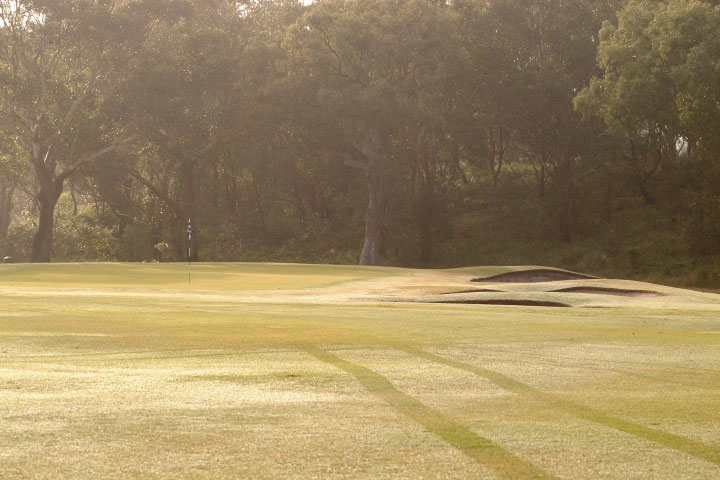
After clearing a valley from the tee, the last 120 yards of the one shot third is over level ground, an uncommon sight at Newcastle. The green is open in front, a design attribute that any one shotter of this length should possess.
Fourth hole, 455 yards; The perfect compliment to the third, this one is a reachable par five. Save for a group of bunkers down the right, the tee shot is fairly open, encouraging a big drive. From there, the hole narrows considerably to the green perched on top of a dune. A birdie awaits but the green is appropriately the most severely pitched on the course, so beware. The golfer is given eight shots for the third and fourth holes; where he decides to take them is up to him.
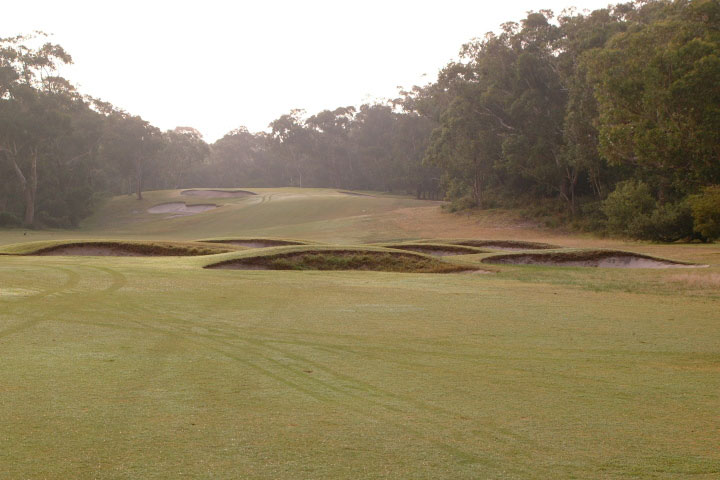
A nest of bunkers eat into the fourth fairway on the right. The closer the golfer drives to them, the better chance he has to reach the elevated green on his next.
Fifth hole, 405 yards; One of the great holes in Australia and indeed world golf. The decision on how aggressive to be on this medium length hole is made on the tee. A driver drawn over the first sand dune slings off the natural valley and leaves the golfer with a short iron into the green. However, if the draw isn’t executed properly and ‘missed straight,’ the tee ball ends up ona bush covered dune. The same fate awaits if the draw is overcooked as well. Therefore, many a golfer opts for a long iron off the tee, leaving a mid iron into a green that all of a sudden doesn’t look too big. The course’s deepest greenside bunker eats into the green’s left and the surrounding land feeds into this gathering pit. On the green’s right, two more bunkers await. A promising start comes to ruin as the golfer ping pongs from the bunker on the left to the bunkers on the right.
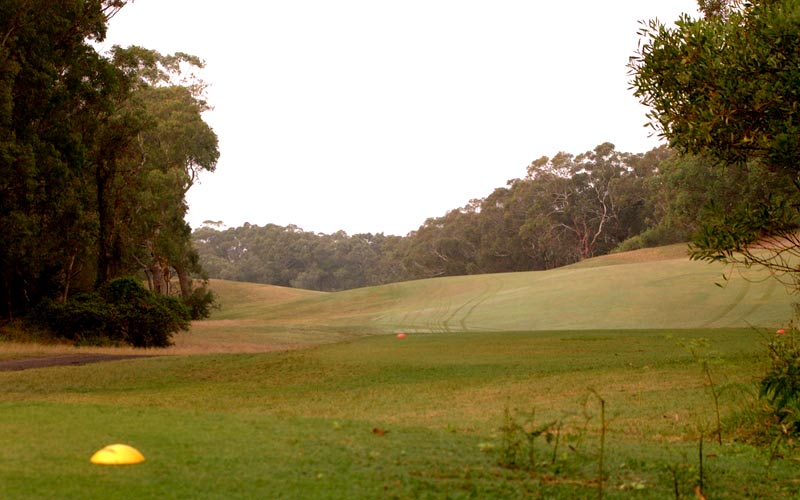
The view from the fifth tee is a puzzler for the first time golfer. Would any modern architect have the courage to leave the landforms largely untouched as Apperly did in the 1930s? The author doubts it and more is the pity as the unique landforms make a one of a kind challenge.

A perfect drive feeds through the dunes and leaves this manageable approach to the fifth green. Medium in size, the green calls for an accurate approach with the gathering bunker on the left needing to be avoided at all costs.
Sixth hole, 420 yards; The favorite hole of many members. The proper drive stays right of the sand dune that encroaches from the left. Indeed, the sand dune on the left may be used to help the tee ball find the only flat part of the fairway. From there, a mid-iron shot is required to an elevated green located in a saddle. The green falls naturally from back to front and is swift.

The 6th was selected by Golf Magazine as one of the world’s 500 best holes. The tee ball pictured above feed off the dune on the left and offers the golfer a level stance from which to hit his approach. The key to the approach is to reach the green while staying below the day’s hole location.
Seventh hole, 160 yards; In The Confidential Guide, Tom Doak shrewdly elected this par three as the best seventh hole in the world, outside of the United States and the United Kingdom. The two pit bunkers fronting the right of the green encourage most players to go long. Over is death though as the green features a considerable back to front pitch. The tee is the highest point on the front nine so the golfer needs to take full account of the wind, especially as the Pacific Ocean is within 1,200 yards from the tee. Controlling the flight of a ball in the wind on a hole of this length is always an intriguing proposition; the better golfer is often readily identified.
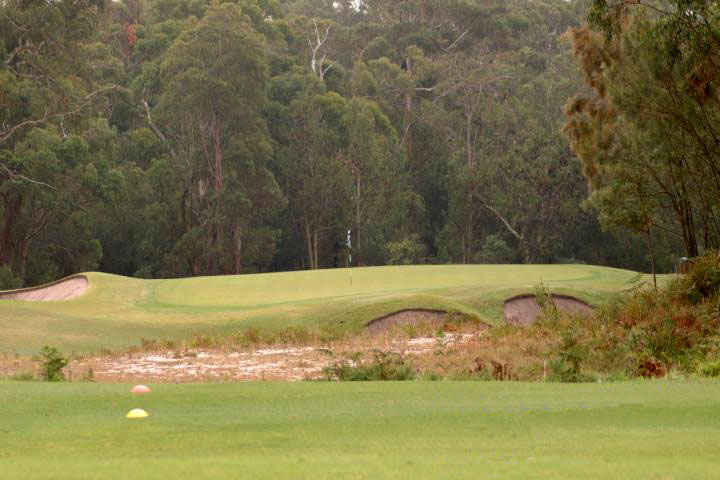
The short seventh with deep bunkers in front and a drop-off behind the green. As well as any course in the world with which the author is familiar, the design at Newcastle Golf Club rewards crisp iron play.
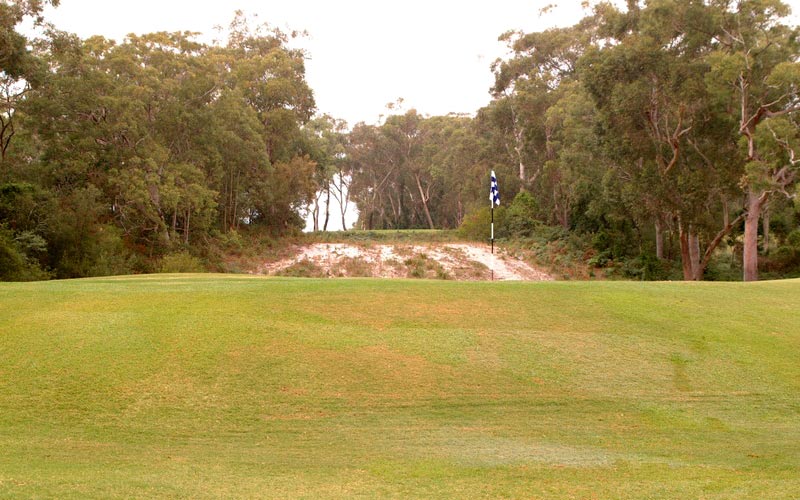
This view from behind the seventh green highlights two aspects: the superb sandy soil upon which the course is built and the tightly mown banks that feed balls off its greens.
Eighth hole, 360 yards; A subtle hole of great merit, Apperly swung the fairway to the right around a dune line. Along tee ball of some 250 yards to the outside of the dogleg is worth a lot here as it leaves a clear view for one’s pitch to the small green. Otherwise, off-line tee balls or ones hit too weakly with a three wood strand the golfer with a blind or semi-blind approach shot.
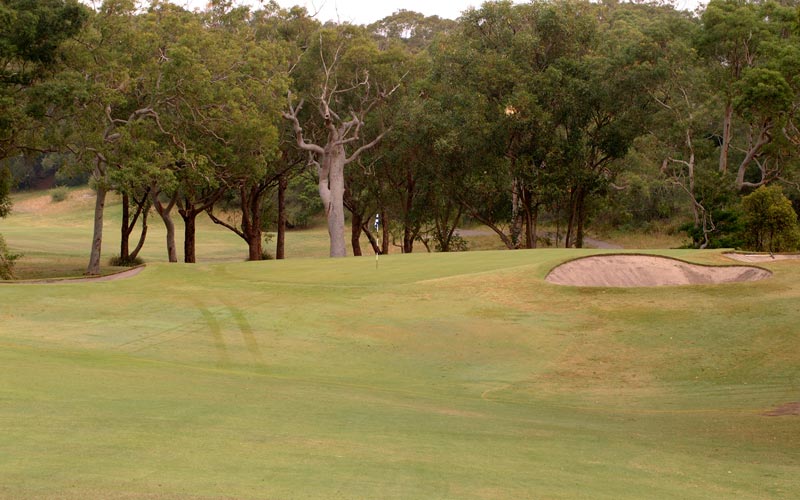
The eighth green is typical of the challenge at Newcastle as it is the high point of its surrounds and it offers none too big a target. The clean line of the green’s horizon lends the course an air of unforced simplicity as the green lays peacefully upon the landscape. From a golfing perspective, the lack of insipid mounds framing the green means plenty of approach shots feed off the back, leaving a variety of ticklish recoveries.
Tenth hole, 530 yards; The architects brilliantly used two dune lines to give this hole its golfing merit. The fairway goes over the crest of the first dune a little over two hundred yards from the tee where as a second dune line bisects the fairway one hundred yards shy of the green. The position of the second dune essentially means that the golfer must cover 430 yards in two shots or face a blind third shot. Fortunately, a well hit drive that carries the crest of the first dune gets a big kick forward down the fairway. The golfer can now carry the crest of the second dune and maybe even reach the putting surface in two. That is how the hole is ideally played. Unfortunately, the less than perfect drive often means a pitch out from the Australian bush that tightly borders this fairway. Plus the missed tee ball likely didn’t get much run down the back side of the first dune. Thus, even after a successful pitch out, the golfer might well be left with a blind three wood to the green. In a typical group of four good golfers, the difference between the low and high score in the group is often three shots. Another of Newcastle’s thoroughly unique holes, great shots get handsomely rewarded on this roll-a-coaster par five while poor shots quickly mount into a mess.
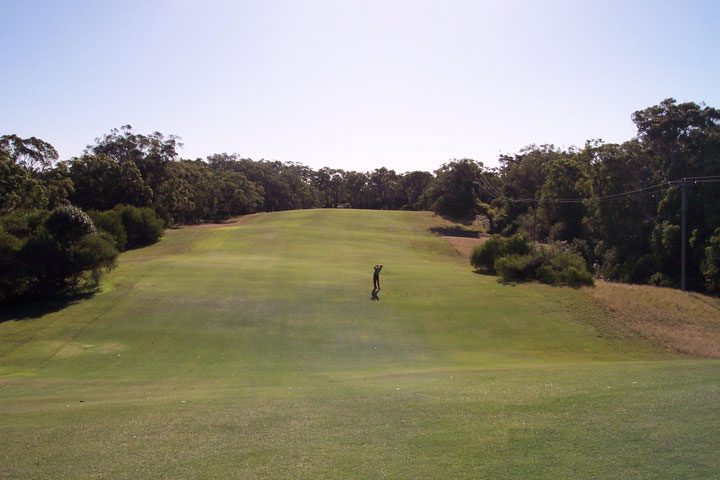
As seen above, this golfer hit the ideal drive at the tenth. His big tee ball bounded down the first dune and ran up the next one. From there the golfer has 230 yards to a green that is one hundred yards past the fairway’s horizon.
Eleventh hole, 370 yards; Similar to the eighth, this hole is cleverer than its modest length might suggest. The fairway is full of folds and finding a level stance is a rarity. Thus, the task becomes to control one’s short iron approach shot from a sloping stance to a 3,500 square feet green on top of a knob. Some days, the going gets especially tricky when the golfer finds himself with a downhill stance and the hole is playing downwind. Of course as the fates would have it, other days he will have an uphill stance into the wind. The fact that the permutations in playing the hole (as well as the rest of the course) vary so much from day to day is one of the primary reasons why links golf is superior to any other form. Topography plus sandy, firm playing conditions plus wind are an unbeatable combination for great golf and Newcastle possesses all three attributes in spades.
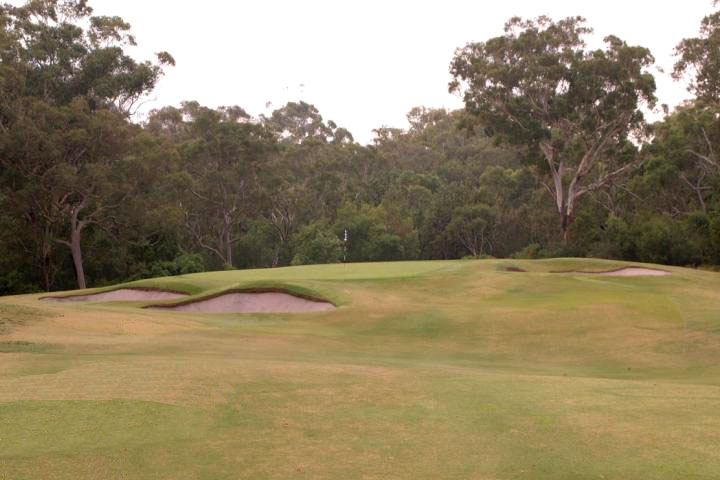
The approach to the eleventh is often from an uneven stance to a medium size green that is easy to miss when the wind is about. The green’s right to left tilt makes recovery tough from shots missed right.
The Finish (14th-18th); Like the East Course at Merion Golf Club, the last five holes feature four tough two shotters and a 225 yard one shotter, giving Newcastle its own distinctive personality. Woe is the man who steps onto the 14th tee and does not have his score in good repair. Too many modern courses have formulaic finishes with blandness confused for design balance.
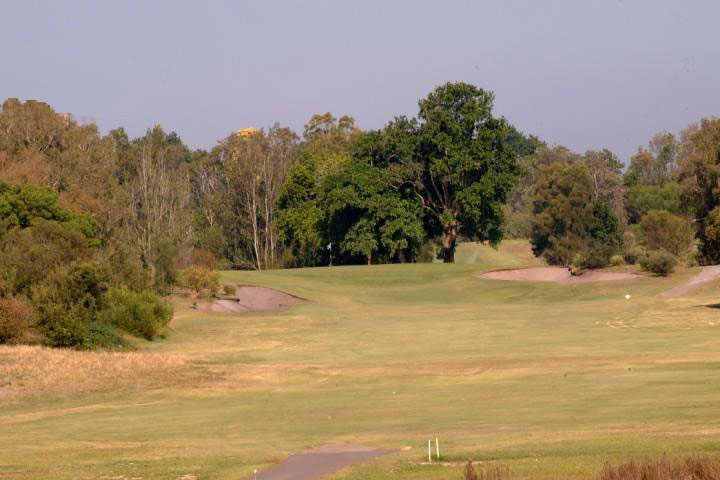
Unlike the 14th and 15th holes that feature blind drives over ridges, the elevated 17th tee provides a commanding view down the length of this 440 yard hole. The beautifully placed green atop a dune line features a false front and is one of the most elusive to hit and hold on the course.

The approach to the Home hole. The green’s back to front pitch is consistent with its surrounds.
Similar to Pine Valley and Augusta National, the drive to the course does not inspire thoughts of golf as one passes through a steel plant. Nonetheless, the welcome is very warm and the golfing membership is extremely knowledgeable. A four hour round remains sacrosanct – even on Saturday’s competition day – and walking is de rigeur. In short, the best virtues of golf are alive and well.
From the opening tee shot to the last putt, all aspects of the golfer’s game are challenged while he enjoys an uninterrupted walk through land unspoiled by man’s hand. Isn’t that what golf is supposed to be? Rather than try to overpower the course, the thoughtful golfer who keeps his ball in play off the tee and underneath the hole on his approach finds a round at Newcastle to be one of the most satisfying exercises in course management that the game offers.
The author gratefully acknowledges and thanks Andrew Summerell for the use of his photographs.
The End




![Royal Melbourne (West) [2017]](https://golfclubatlas.com/wp-content/uploads/2016/03/RME16gb-500x383.jpg)

